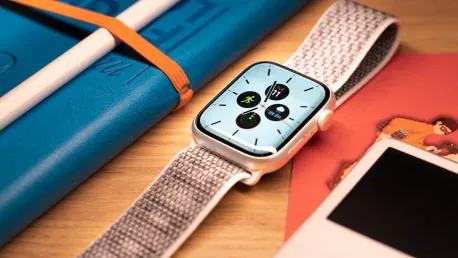Smartwatches and fitness trackers have become ubiquitous, worn by over 100 million Americans, including a growing number of children. Marketed for their health benefits, these devices promise to enhance our well-being by tracking physical activity, heart rate, and even sleep patterns. However, beneath their sleek and functional exterior lies a host of hidden dangers that users need to be aware of. This article explores two primary areas of concern: toxic chemical exposure and data privacy vulnerabilities.
Toxic Chemical Exposure in Fitness Tracker Bands
The Prevalence of PFAS in Fitness Bands
Recent research from the University of Notre Dame has uncovered a troubling aspect of fitness trackers: many of their bands are infused with per- and polyfluoroalkyl substances (PFAS). Known as “forever chemicals” due to their resistance to breaking down in the environment, PFAS can accumulate in soil, water, and the human body, leading to a range of health issues. These substances have been linked to cancer, hormonal disruptions, developmental delays in children, and weakened immune systems. The fact that these dangerous chemicals are present in devices worn constantly against the skin heightens the potential for significant health repercussions.
Dermal Absorption and Health Risks
The primary concern with smartwatches and fitness bands is dermal absorption. These devices are often worn for extended periods, allowing PFAS to seep into the skin continuously. This prolonged exposure elevates health risks, particularly when the skin is warm or sweaty, conditions often met during exercise. For children, whose developing bodies are more vulnerable to chemical exposure, the risks are even more pronounced. Long-term exposure can interfere with growth, disrupt puberty, and alter hormonal pathways. Furthermore, PFAS have been proven to disrupt testosterone levels in men, which is crucial for maintaining energy, muscle mass, and mental well-being.
Price and PFAS Levels
The Notre Dame study revealed that pricier bands often contain higher levels of PFAS. Bands costing over $15, particularly those made of fluoroelastomers (a type of synthetic rubber), exhibited alarmingly high concentrations of PFHxA, a specific type of PFAS. Some bands contained over 1,000 parts per billion (ppb) of PFAS, while regulatory levels in drinking water are concerning at just four parts per trillion (ppt). This stark comparison underscores the potentially dangerous PFAS exposure from wearing fitness bands. Lower-cost bands generally exhibited lower levels of fluorine, indicative of fewer PFAS, but they were not entirely risk-free.
Data Privacy Vulnerabilities
Collection and Transmission of Personal Information
Smartwatches and fitness trackers collect and transmit a vast array of personal information, from heart rate and location to daily routines. This data is often shared with third parties, including advertisers and data brokers, without clear transparency. The lack of control over who has access to this information raises significant concerns over potential misuse. Users may unknowingly expose sensitive data that could be exploited for various purposes. This exchange of data, often without explicit consent, places users at significant risk, with possible breaches impacting not only privacy but also personal safety on a broader scale.
Risks of Publicly Shared Location Data
Location data, often shared publicly to track exercise routes or for competitive purposes, poses additional risks. Cybercriminals or predators could analyze this data to identify patterns, leading to security breaches. A notable incident in 2018 highlighted this vulnerability when U.S. military bases were unintentionally exposed through publicly shared fitness tracker data. This example underscores the potential dangers of sharing location information without adequate safeguards. The ability to track repetitive patterns could allow malicious actors to predict user routines, presenting an avenue for targeted attacks or personal risk that many may not even contemplate when using these devices.
Security Flaws in Children’s Smartwatches
For children, the risks are even higher. Parents often invest in GPS-enabled smartwatches for safety, but security flaws in these devices can allow unauthorized access. Researchers have discovered vulnerabilities that permit outsiders to track children’s movements or even communicate with them directly. This poses a significant risk of exploitation, as malicious actors could use this information to harm or manipulate children. In many cases, the technological safeguards are insufficiently robust, leaving young users exposed to a realm of digital threats that can have very real-world consequences, influencing parental decisions about the utility versus the risk of such gadgets.
Recommendations for Mitigating Risks
Limiting Use and Removing Devices
Given the significant hidden dangers associated with smartwatches and fitness trackers, it is advisable to reconsider wearing these devices around the clock. Limiting their use or removing them during certain activities can mitigate some of the outlined risks. For children, it is particularly important to avoid prolonged exposure to these devices to protect their developing bodies from harmful chemicals and potential exploitation. Parents need to weigh the perceived benefits against the possible long-term consequences, recognizing that sometimes traditional methods of ensuring safety and monitoring health might offer a better balance between utility and safety.
Prioritizing Natural and Healthy Activities
Instead of relying solely on smart devices, consider incorporating more traditional methods of health monitoring and activity tracking. Engaging in physical activities without technological aid, such as playing sports or participating in outdoor activities, can be equally effective in maintaining health and fitness. Practicing mindfulness and being attuned to one’s body without technological intervention can also promote a balanced and healthy lifestyle. For children, encouraging play and participation in physical activities outside of digital monitoring can not only foster physical health but also contribute to overall well-being.
Smartwatches and fitness trackers have become incredibly popular, with over 100 million Americans now wearing these devices, including a growing number of children. They are heavily marketed for their perceived health benefits, promising to enhance our well-being by tracking various metrics, such as physical activity, heart rate, and sleep patterns. However, behind their sleek design and functionality, there are hidden dangers that users must be vigilant about. For instance, these devices have been found to contain toxic chemicals that can pose health risks. Additionally, there are significant concerns regarding data privacy vulnerabilities. These gadgets collect a vast amount of personal health information, making it crucial for users to be aware of how their data is being used and secured. This article aims to delve into the dual concerns of toxic chemical exposure and data privacy risks associated with smartwatches and fitness trackers, highlighting the need for greater awareness and precautions when using these popular devices.









